CASE STUDIES
Florida: Efficient Transportation Decision-making Process
Agencies and Organizations Involved
Federal
- Advisory Council on Historic Preservation*
- Federal Highway Administration (FHWA)*
- Federal Transit Administration (FTA)*
- National Marine Fisheries Service (NMFS)*
- National Park Service (NPS)*
- National Resources Conservation Service (NRCS)*
- U.S. Army Corps of Engineers (USACE)*
- U.S. Coast Guard (USCG)*
- U.S. Environmental Protection Agency (EPA)*
- U.S. Fish and Wildlife Service (USFWS)*
- U.S. Forest Service (USFS)*
State
- Florida Department of Agriculture and Consumer Services*
- Florida Department of Community Affairs*
- Florida Department of Environmental Protection*
- Florida Department of State*
- Florida Department of Transportation (FDOT)*
- Florida Fish and Wildlife Conservation Commission*
- Florida Metropolitan Planning Organization Advisory Council*
- State Historical Preservation Officer*
Local
- Northwest Florida Water Management District (NWFWMD)*
- South Florida Water Management District*
- Southwest Florida Water Management District*
- St. Johns River Water Management District*
- Suwannee River Water Management District*
Tribal
- The Seminole Tribe of Florida
- The Miccosukee Tribe of Indians of Florida
*Signatory on the original MOU
For additional information, please contact Buddy Cunill, Environmental Program Development Administrator at the Florida Department of Transportation at (850) 414-5280.
Section 1: Overview
In response to the Transportation Equity Act for the 21st Century (TEA-21) of 1998, FDOT initiated the Efficient Transportation Decision-making Process (ETDM), a system designed to streamline the transportation planning and project development process without compromising the quality of Florida’s human and natural environments. The goal of the project was to develop a process for early and continuous resource agency input into the FDOT environmental review, decision making, and permitting process to make project delivery more efficient and less costly. As in many States, prior to development of ETDM, Florida’s transportation planning and project development process could take 10-15 years due to long periods between process steps and late agency involvement.
“Let’s get everyone at the table and find out what we can do” was the initial attitude and approach to the development of ETDM. –
Buddy Cunill, FDOT
In February 2000, FDOT convened Federal, State, and local agency representatives at an executive summit to request their support in reexamining the entire transportation planning and project development process, including environmental review and permitting cycles. The vision statement developed at the summit called for “a systematic approach that integrates land use, social, economic, environmental, and transportation considerations” and “lead[s] to decisions that provide the highest quality of life and an optimal level of mobility for the public we serve.”
Participating resource agencies and metropolitan planning organizations (MPOs) were asked to designate one point of contact to serve on multi agency work groups. These work groups were designed to address specific components of transportation planning and project development, including socio-cultural effects, public involvement, indirect and cumulative effects, and performance management. Many of the initial work group meetings involved information sharing among the participants. These meetings gave all parties a better understanding of Florida’s mobility needs and the associated issues for the environment and local communities. Later in the process, agency representatives were asked to examine which changes would make their environmental review process easier and more streamlined. Much of ETDM’s development was based on feedback from individual agencies about what would be the most beneficial information for their daily activities. Many of the agencies had already been through internal review processes for transportation plans, and much of the resulting information was incorporated into the overall ETDM process.
In all, 24 Federal, State, and regional agencies participated in development of the ETDM process and associated technology. They signed a memorandum of understanding (MOU) committing them to continued development and implementation of the ETDM process. The MOU outlined how the ETDM process would involve agencies and ensure continuous agency participation. It also provided agreement on which agencies required access to project and resource data in order to provide input into project development and planning. The goal of the ETDM process was to provide an improved method of issuing environmental permits . The MOU was initially supported by a Master Agreement and Agency Operating Agreements as addenda.
The ETDM screening phases allow FDOT to focus on issues that warrant further evaluation during project design and development . The phases have also minimized the number of project alternatives that are considered in detail during the environmental review.
The ETDM process is composed of three phases: Planning, Programming, and Project Development (see figure 2). The Planning and Programming phases are screening processes, which engage resource agencies early. The Planning Screen is completed during development of long-range transportation plans by MPOs . Agency participants review the Purpose and Need Statement, and provide comments on potential impacts to environmental and community resources. This allows planners to adjust project concepts to avoid or minimize impacts, develop alternatives, and produce accurate cost estimates by examining land use issues, ecosystem management, community insight, and mobility concerns.
The Programming Screen results in a report that summarizes the project details, including the project description, summary of public and agency comments, and project purpose and need. The screen provides information on the history of identified alternatives and the Environmental Technical Advisory Team’s (ETAT) reviews of direct, indirect, and cumulative effects.
As a result of the two screening phases, FDOT is able to focus efforts on issues that warrant further evaluation during project design and development, rather than on proving that issues do not exist. The phases also minimize the number of project alternatives that are considered in detail during the environmental review.
Figure 1. Illustration of EST process from input to user interface
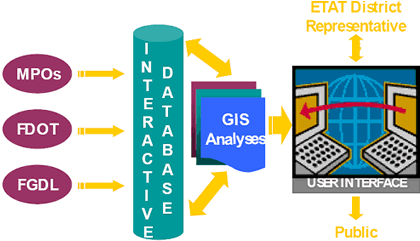
Throughout the ETDM process, the Environmental Screening Tool (EST), an Internet-accessible interactive database, is used to document project changes, evaluate impacts, and communicate project details to agencies and the public. MPOs, FDOT, and the Florida Geographic Data Library enter information, which is translated into geographic information system (GIS) data layers, and made available to the public.
Once priority projects have been selected for inclusion in FDOT’s Five-Year Work Program, they enter the programming Screen . This phase allows the agency to identify potential problems and issues that might arise in the environmental review and permitting process through public and agency scoping, including compliance with Federal and State environmental laws . If issues cannot be resolved, they enter the dispute resolution process. USFWS has found the process helpful in flagging potentially problematic projects.
Agency interaction throughout the planning and project development process is extremely important to the ETDM process . This interaction is facilitated through ETAT groups that have been developed in each of the seven FDOT districts to include one representative from each of the planning, regulatory, and resource agencies in the district . Each ETAT provides a forum for public and agency scoping, field reviews, support, technical studies, and environmental document review.
Figure 2. The ETDM process from Planning to Programming and Project Development
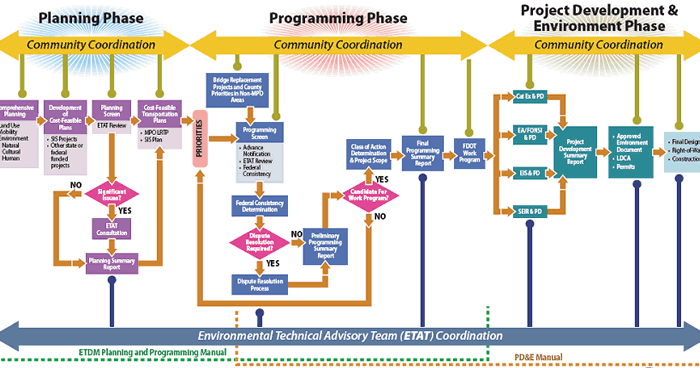
Integrated Planning Applications
The EST brings together information and project plans from MPOs and FDOT. The EST provides standardized analysis of proposed projects using resources developed by ETAT, giving commenting agencies the opportunity to compare projects and potential impacts. Summary reports are developed by ETDM Coordinators and contain key recommendations and conclusions for the potential impacts identified by ETAT. These recommendations serve to guide planners in determining transportation priorities and provide feedback to participating agencies and the general public. Environmental concerns are integrated to the project development process from an early stage through use of the EST.
Currently the EST database houses information on 1,158 projects. ETDM coordinators send out e-mail notification of proposed projects to agencies for comment. Some agencies review upwards of 35 projects per year, depending on their jurisdiction and interest. Since 2003, more than 274 projects have successfully completed the ETDM process.
Section 2: Data and Tools
FDOT’s EST is integral to the ETDM process. Data for this Internet-accessible interactive database tool is collected from all of the resource agencies involved in transportation planning and review, then fed into the Florida Geographic Data Library’s comprehensive digital information database. In addition, FDOT and local MPOs can enter project-related data into the system, which is integrated and disseminated to resource agencies and the public. FDOT developed an Internet-accessible interface that allows users to conduct GIS queries and analysis.
The EST was developed in a collaborative environment to accurately reflect the needs of each participating agency. Joint application development sessions featuring evolutionary prototyping were used to develop priorities that fit user needs. The tool was also designed to allow for cross-agency coordination and information sharing.
EST users can view the affected area of a project and complete basic GIS analysis automatically to highlight areas of concern. For example, most analyses include National Register sites that lie within 1 mile of the project, wetland acreage and type affected by the project, and contaminated sites located within 1 mile of the project (figure 3). Based on this information, agency representatives can coordinate internally and form a position on the proposed project.
Figure 3. Screen capture of the EST GIS analysis
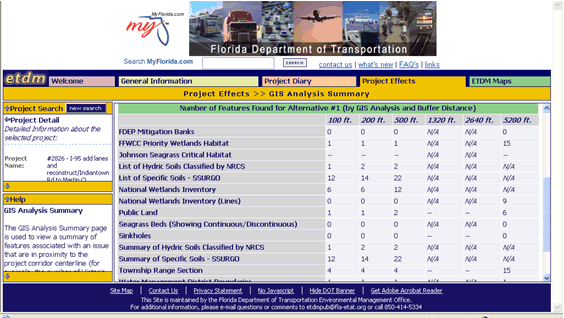
The application has two user interfaces: a read-only site available to the public and a secure-entry site available to contributing resource agencies. Each agency is required to submit digital information at no cost about the resources it protects. Each data source is on a different update cycle, ranging from biweekly to annual updates. Reminder e-mails are sent to contributing agencies when their datasets are due. In addition, each agency’s ETAT representative is responsible for sending new information about agency plans, initiatives, biological assessments, research projects, and field reviews within 90 days of completion. Once this information has been received, a quality assurance/quality check (QA/QC) is completed on all data before it is published. In addition, before a new data layer can be published in the system, it must pass through an internal review, including a final review by the submitting agency. Once new data has been uploaded, the system distributes an automated electronic notice to registered users.
Currently, EST features approximately 500 data layers, most of which are available for public review. Data layers that fall into one of the following categories are generally not available to the public:
- Data sets that are exempt from public records (e.g., archeological sites)
- Licensed data sets
Agencies often submit overlapping data sets. Rather than prioritizing one agency’s data set over another, EST presents each agency’s information as a different set of GIS layers. This allows the user to decide which information is most useful.
The EST user community is made up of approximately 500 representatives from 24 resource agencies, 26 MPOs, 6 FDOT districts, 2 tribal governments, and the public. The number of individuals accessing EST was too large for the data to be housed on a firewalled server within FDOT, so it wa s housed on servers provided by the University of Florida’s GeoPlan Center. GeoPlan also handles much of the database administration, including developing online project reviews, generating reports, and archiving the data. However, agency representatives are responsible for ensuring that their data is current.
In addition to a user’s guide and training syllabus that is available online, support and training staff are in place to assist EST users. Help Desk staff provide user support during regular business hours, and training is available upon request.
Section 3: Scheduled Cooperation and Interaction Processes
The ETDM process is coordinated by local ETAT Representatives and ETDM Coordinators. This organizational structure was outlined in the MOU. ETAT representatives are responsible for ensuring that the actions carried out by the ETAT teams satisfy the statutory obligations of their agencies. Therefore, it has proven important that these representatives are knowledgeable of their internal agency approval processes and have access to key leaders within their respective agencies. It has also been important that this Representative accurately present the concerns and preferred alternative s of the agency on project-related matters. The ETDM coordinator is the ETAT member representing the FDOT district. This person is in charge of coordination outside the ETAT with district management, project managers, MPOs, and consultants. At the local level, community liaison coordinators are responsible for informing communities of potential project-related impacts, including conducting public outreach, identifying socio-cultural effects, and making summary reports available to the public. These Coordinators are expected to reflect community opinions when meeting with ETAT members.
To affirm the cooperative environment, all written agreements were set and renewed with certain timeframes. In addition, all decisions were made through the mutual agreement of everyone at the table. As previously discussed, an automated conflict and dispute resolution process starting with the Planning Screen and ending with the Programming Screen was developed to ensure that all future disagreements were appropriately resolved and documented. These conflicts often revolve around projects that are contrary to goals and policies seTout by the State of Florida or the Federal Government, are unable to be permitted, have a purpose and need disputed, or involve a very high cost to the agency. If conflict arises during the Planning Screen, ETAT Representatives and the ETDM Coordinator work to resolve the issue. If the problem persists, the project is flagged as it goes into the Programming Screen. If the issue cannot be resolved at the local level, it is passed along to statewide or regional agency leads, who review the project information and associated technical studies. The project can be modified to resolve issues, advanced, rejected, or deferred to the governor to make the final decision.
Section 4: Legal Framework
In addition to the MOU signed in December 2001 stating the goals and principles of the project, participating agencies are responsible for signing three additional agreements with FDOT and FHWA: the Master Agreement, Agency Operating Agreement, and Funding Agreement. The Master Agreement notes an agency’s acceptance of the overall ETDM process and associated performance standards, dispute resolution process, and regulatory authority. Originally, the Master Agreement was renewed every 2-5 years. Currently, signed Master Agreements are for a period of 5 years. The Agency Operating Agreement presents the specific responsibilities of the signing agency, including formal concurrence points and required permits. Last, the Funding Agreement presents the interagency funding requirements necessary for an agency to participate in the ETDM process, including full-time equivalent positions, travel, training, and equipment. Quarterly status reports, review forms, annual reports, and semi annual feedback reports are associated with the Funding Agreement.
Any agreement modifications must be agreed upon by the same agency officials who executed and approved the original document. In addition, any agency can terminate its agreement if 60 days notice is given to the ETDM Coordinator.
Section 5: Leadership Role
Initial collaboration between FDOT and FHWA staff allowed for the preliminary information gathering that eventually led to the first inter agency summit. Together, staff from these agencies worked to bring leaders from key agencies together to discuss issues and lay out a vision for what would become ETDM.
While ETDM began as a top-down executive leadership effort, it has continued through bottom-up agency coordination and leadership. Leaders from 23 Federal, State, and local transportation and resource agencies met at a summit meeting in February 2000. This meeting garnered high-level agency support to ensure continued momentum.
Section 6: Funding Sources and Liaisons
Prior to ETDM, there were no positions at resource agencies fully devoted to FDOT work. Since the project’s inception, 35 positions have been funded through ETDM for work starting in the project planning phases and continuing through the construction phase. Each agency was different in which resources it could devote to the effort, and the program was able to fund a wide variety of hiring situations. Some agencies were able to hire temporary or full-time equivalent employees, while others outsourced the work to consultants. All funded positions were designed to work solely on FDOT projects, which allows for more open communication between agencies and full involvement of agencies throughout the transportation planning, programming, National Environmental Policy Act (NEPA), design, and construction processes. Having a point of contact at each agency has been very helpful to maintain continuity and institutional knowledge.
For Fiscal Year 2006 -2007, $4.7 million in encumbered funds was designated by 17 agencies. Of that amount, $480,794 was spent by those agencies in that fiscal year. Unspent funds are reinvested into the program and utilized in future years.
FDOT, FHWA, and the resource agencies meet annually to review the funding program and discuss process issues and program accomplishments. Funding agreements are renewed for another year if all parties agree.
Section 7: Performance Measures and Outcomes
Early in the development of ETDM, FDOT determined that collecting, evaluating, and reporting on the performance of the program was integral to the success of the project. The ETDM Performance Measures Task Work Group was formed in February 2004 and met for two 2-day workshops and three teleconferences. Members of the Work Group included representatives of FDOT, FHWA, USCG, USFWS, U SACE, and NWFWMD.
To evaluate existing performance measures, the Task Work Group conducted literature reviews, identified possible challenges, and established three preliminary goals:
- Integrate ETDM into project delivery
- Improve interagency coordination and dispute resolution
- Develop environmental stewardship through protection of environmental resources
In its 2005 ETDM Performance Management Plan, the Task Work Group published 18 preliminary qualitative and quantitative measures that could be used to monitor each of these goals during the planning, programming, and project development stages.
Shortly after the 2005 report was published, the FDOT Central Environmental Management office (CEMO) began to collect information about the environmental review process of previous FDOT transportation projects (e.g., project schedule, funding, and agency interaction). This information, combined with extensive discussions between the agencies, is being used to develop the final performance goals and expectations for each agency. The performance measures that are already in place include:
- Agency response received within the agreed-upon review period;
- Percent and number of projects in dispute;
- Percent of disputes resolved within 120 days;
- Percent of projects for which a review extension was requested;
- Percent of summary reports published within 60 days; and
- Number of projects with a Class of Action resulting in an Environmental Impact Statement (EIS), Environmental Assessment (EA), or Type 2 Categorical Exclusions.
Figure 4. The ETAT performance measure indicator system showing the number of projects completed within the review period
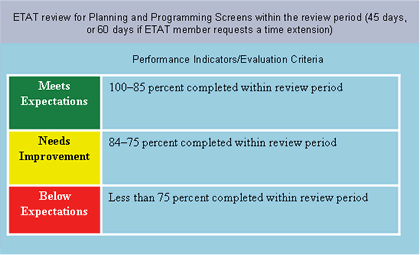
Figure 5. The ETAT performance measurement process
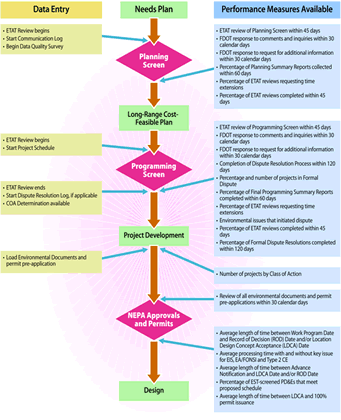
Each performance measure is developed with a set of targets and ranges using a tri colored indicator system. Green indicates efficient operation, yellow is a warning of potential problems, and red identifies a problem requiring corrective action (figure 4). The cut-offs for each level of performance are developed based on goals set by FDOT and FHWA, as well as discussions with the specific agencies. The final list of performance measures is currently under development and should be finalized in late 2007 or early 2008.
Much of the information used to assess performance, expectations, accountability, and accomplishments is already being collected from each agency via on line surveys ; paper surveys ; annual reports ; one-on-one discussions and interviews ; annual peer review meetings in each district ; and workshops, seminars, and annual meetings hosted by FDOT. Most importantly, each agency is required to submit frequent updates based on the project schedule to the EST. FDOT has found the information already in the EST to be extremely helpful, as agencies and districts already submit this data as part of their regular work flow. The EST can be queried to develop an evaluation scorecard for each agency using the tri colored indicator system. If an agency receives a red or yellow classification, FDOT and FHWA work with it to determine the challenges and barriers that are causing the problem, then help develop a solution. The overall success of the ETDM performance management system is based on this ability to catch problems early and open lines of communication between agencies and districts.
Section 8: Lessons Learned
More than 274 projects have successfully completed the ETDM process, and have done so in a less costly and time-consuming manner than would have occurred without the process. Throughout the development stages, changes have been made to the process to address road blocks and reflect lessons learned. Some of these key lessons are listed below:
- Performance Management. A method of measuring agency performance was developed to monitor the time needed to complete document review, turnaround, and processing. Qualitative and value-added measures, such as type of comments submitted, are included in the performance management program. In addition, FDOT is currently working with its districts to develop an automated online performance tracking system with a two-way feedback tool so that the districts can monitor the performance of FDOT headquarters, and vice versa.
- Involvement. Early involvement across all agencies allows key players to invest in the process and take pride in the outcome. I t also creates an atmosphere where change is acceptable and expectations can be managed early on.
- Trust Between Agencies. Interagency agreements and open communication are crucial to maintaining trust throughout the process. Regularly held meetings were documented and made available to all participants. Communication among agency points of contact and within agencies was very important for success.
- Conflict Resolution Process. An automated conflict resolution process was developed to document conflicts at any point in transportation plan development. This process gives resource agencies an opportunity to flag issues in proposed projects.
- Early Involvement of Agency Managers and Attorneys. All decisions must go through agency supervisors and their attorneys. These players should be brought to the table early on so that decision making can be a smoother process.
- Documentation. Common program issues and decisions should be documented in program reference manuals in case similar problems arise later.
- Mutual Development of Agreement Language. All representatives should be involved in crafting the language of agreements. A forum should be developed so all agencies can remain involved through a Web site, e-mails, or teleconferences.

